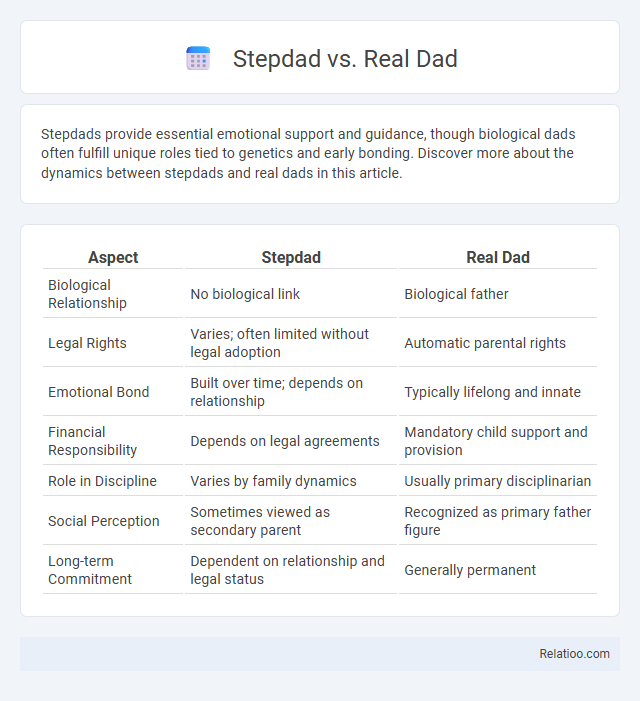Stepdads provide essential emotional support and guidance, though biological dads often fulfill unique roles tied to genetics and early bonding. Discover more about the dynamics between stepdads and real dads in this article.
Table of Comparison
| Aspect | Stepdad | Real Dad |
|---|---|---|
| Biological Relationship | No biological link | Biological father |
| Legal Rights | Varies; often limited without legal adoption | Automatic parental rights |
| Emotional Bond | Built over time; depends on relationship | Typically lifelong and innate |
| Financial Responsibility | Depends on legal agreements | Mandatory child support and provision |
| Role in Discipline | Varies by family dynamics | Usually primary disciplinarian |
| Social Perception | Sometimes viewed as secondary parent | Recognized as primary father figure |
| Long-term Commitment | Dependent on relationship and legal status | Generally permanent |
Understanding the Roles: Stepdad vs Real Dad
Understanding the roles of a stepdad versus a real dad involves recognizing the unique dynamics and emotional bonds in blended families. A real dad typically shares biological ties and legal responsibilities, while a stepdad often builds relationships through support, trust, and active involvement in Your child's life. Both roles contribute significantly to a child's development, emphasizing love and commitment beyond genetics.
Emotional Bonds: Building Connections with Children
Emotional bonds between children and stepdads often develop through consistent presence, trust-building activities, and respectful communication, fostering a deep connection despite the absence of biological ties. Real dads typically have an innate bond rooted in biology and shared history, but emotional closeness depends on active involvement, empathy, and support in the child's life. Stepparents, including stepdads, can create meaningful relationships by validating the child's feelings, establishing clear boundaries, and participating in family traditions, which strengthens their emotional connection over time.
Legal Rights and Responsibilities
Legal rights and responsibilities vary significantly between stepdads, real dads, and stepparents, impacting custody, decision-making, and financial support. Real dads typically hold full parental rights, including custody and child support obligations, whereas stepdads acquire limited rights unless legally adopted or granted guardianship. Your role as a stepparent may involve emotional support and caregiving, but formal legal responsibilities usually require court approval or adoption processes.
Navigating Parental Authority and Discipline
Navigating parental authority and discipline between stepdads, real dads, and stepparents often requires clear communication and consistent boundaries to foster respect and cooperation. Real dads typically hold primary legal and emotional authority, but stepdads and stepparents can establish influence through trust-building and aligned disciplinary approaches with the biological parent. Effective co-parenting strategies emphasize collaboration, mutual respect, and understanding the child's needs to create a stable and supportive discipline environment.
Challenges in Blended Families
Challenges in blended families often arise from differing parental roles, where stepdads may struggle to establish authority compared to real dads with biological ties. Stepparents face unique difficulties balancing respect for the child's primary parent while building trust and connection in a new family dynamic. Navigating loyalty conflicts, unclear boundaries, and emotional adjustments are common obstacles as blended families integrate diverse experiences and expectations.
Impact on Child Development
Stepdad, real dad, and stepparent roles significantly influence child development through emotional support, stability, and consistent caregiving. Your child's sense of security and self-esteem thrives when positive relationships, whether biological or step, provide nurturance and reliable guidance. Research highlights that clear boundaries and affectionate bonds within any parental role contribute to healthier social and cognitive outcomes for children.
Communication Strategies for Success
Effective communication strategies for stepdads, real dads, and stepparents involve establishing trust through active listening and empathy, acknowledging the unique roles each parent plays in a child's life. Clear boundaries and consistent messages foster respect and minimize confusion, while collaborative problem-solving promotes a unified approach to discipline and emotional support. Tailoring verbal and nonverbal cues to the child's developmental stage enhances connection and reinforces positive family dynamics.
Overcoming Stereotypes and Misconceptions
Stepdads often face stereotypes of being less involved or less caring than real dads, yet many form deep, meaningful bonds through consistent support and love. Stepparents challenge misconceptions by actively participating in parenting roles, demonstrating commitment regardless of biological ties. Overcoming these stereotypes requires recognizing the dedication and emotional contributions that define effective parenting beyond genetics.
Supporting Children Through Transitions
Supporting children through transitions requires understanding the distinct roles of a stepdad, real dad, and stepparent in their emotional development. Your involvement as a stepdad or stepparent can provide stability and reassurance, complementing the biological father's ongoing connection. Tailoring support to respect the child's feelings while fostering open communication helps ease adjustment and builds trust during family changes.
Fostering Healthy Co-Parenting Relationships
Fostering healthy co-parenting relationships between stepdads, real dads, and stepparents requires clear communication, mutual respect, and consistent boundaries to support the child's emotional well-being. Establishing shared parenting goals and maintaining a united front helps reduce conflicts and promotes stability in blended families. Research from the Journal of Family Psychology highlights the importance of collaboration and empathy in successful co-parenting dynamics.

Infographic: Stepdad vs Real Dad
 relatioo.com
relatioo.com